Do you know that Japanese verbs can be divided into 3 categories? You also need to learn how to conjugate each group. Here’s 124 verbs that you should know to pass the JLPT N5!
Table of Contents
Review of Japanese Verbs
Verbs are words that are used to describe actions, state of something happening, or occurrences. The most important thing about learning Japanese verbs is how to conjugate them, which changes the meaning of the verb - from tenses to politeness level, and affirmative to negative.
To that end, Japanese verbs can be categorised into 3 groups that follow different conjugation rules:
-
る動詞 (ru-doushi) - verbs that end with る (ru)
-
う動詞 (u-doushi) - verbs that end with う (u)
-
する動詞 (suru-doushi) - nouns that becomes verbs when する (suru) is added to the end
Depending on your textbook or Japanese dictionary, the groups may be known by a different name. For example, Ru-verbs as 一段動詞 (ichidan-doushi), and U-verbs as 五段動詞 (godan-doushi).
Writer's Pick
More on Ru-verbs
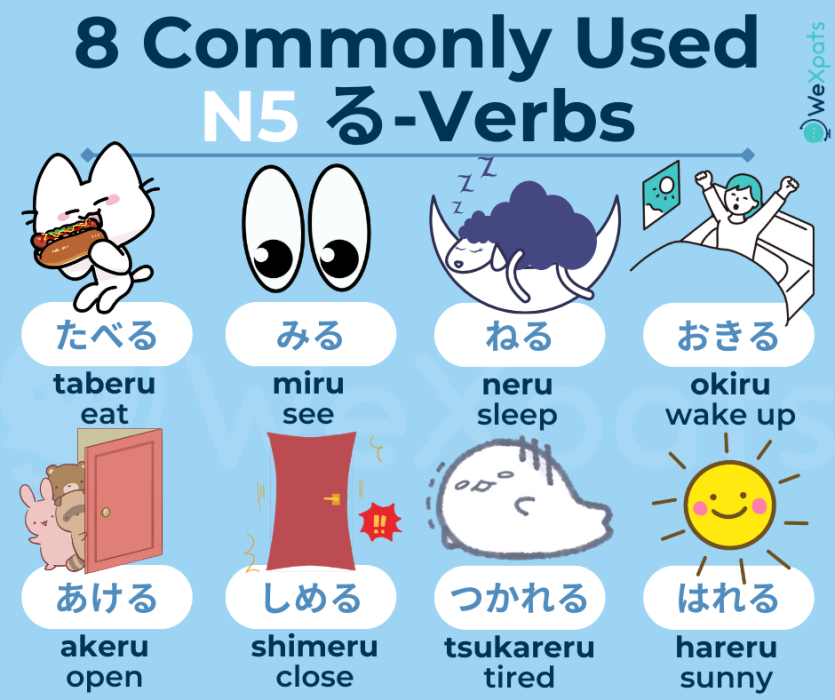
る動詞 (ru-doushi) or Ru-verbs are verbs that end with る (ru).
For example, わたしはパンを食べる (watashi wa pan wo taberu) - I eat bread.
Ru-verbs are easy to conjugate. All you need to do is to change the る (ru) to conjugate the verb into polite form, past tense, present negative, past negative, or present progressive.
Refer to the chart below on how to conjugate Ru-verbs.
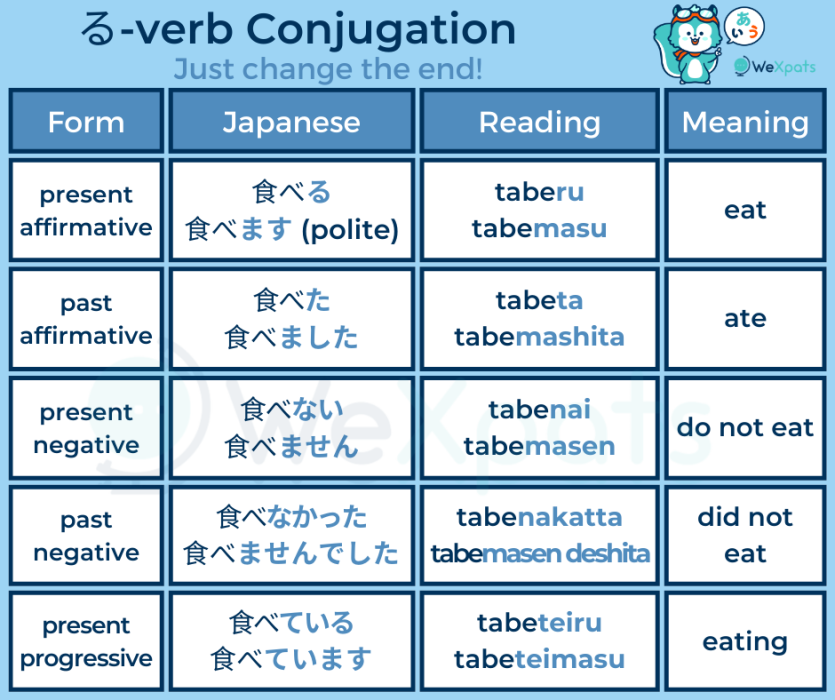
Thus, わたしはパンを食べる (watashi wa pan o taberu) becomes:
-
わたしはパンを食べた (~ tabeta) - I ate bread.
-
わたしはパンを食べない (~tabenai) - I do not eat bread.
-
わたしはパンを食べなかった (~tabenakkata) - I did not eat bread.
-
わたしはパンを食べている (~tabeteiru) - I am eating bread.
Ru-verbs List
Here’s a list of 31 N5 Ru-verbs that often appear on the N5 JLPT test.
Note: The Kanji characters you need to know at the N5 level are indicated in BOLD.
|
あびる |
浴びる |
to shower |
|
あげる |
上げる |
to raise up; to elevate |
|
あける |
開ける |
to open (a door, present, package, etc.); to unlock |
|
でかける |
出かける |
to go out; to leave; to depart |
|
できる |
出来る |
to be permitted (to do); to be able to do |
|
でる |
出る |
to leave; to exit; to go out; to depart |
|
はれる |
晴れる |
to be sunny; to stop raining |
|
いれる |
入れる |
to put in |
|
いる |
居る |
to be; to stay; to be ...-ing |
|
かける |
掛ける |
to hang something up; to make (a call); to wear (glasses, necklace, etc.) |
|
かりる |
借りる |
to borrow |
|
きえる |
消える |
to disappear |
|
きる |
着る |
to wear |
|
こたえる |
答える |
to answer |
|
みる |
見る |
to see |
|
みせる |
見せる |
to show; to display |
|
ならべる |
並べる |
to line up; to set up |
|
ねる |
寝る |
to sleep; to go to bed; to lie down |
|
おぼえる |
覚える |
to remember; to memorise |
|
おきる |
起きる |
got up / get up; woke up / wake up |
|
おりる |
降りる |
to get off (train, bus, etc.) |
|
おしえる |
教える |
to teach; to tell; to inform |
|
しめる |
締める |
to tie; to fasten; to tighten |
|
しめる |
閉める |
to close; to shut |
|
たべる |
食べる |
to eat |
|
つかれる |
疲れる |
to get tired |
|
つける |
付ける |
to attach; to join; to connect; to affix |
|
つける |
to turn on (light, switch, etc.) |
|
|
つとめる |
勤める |
to work for; to be employed at |
|
うまれる |
生まれる |
to be born |
|
わすれる |
忘れる |
to forget |
More on U-verbs
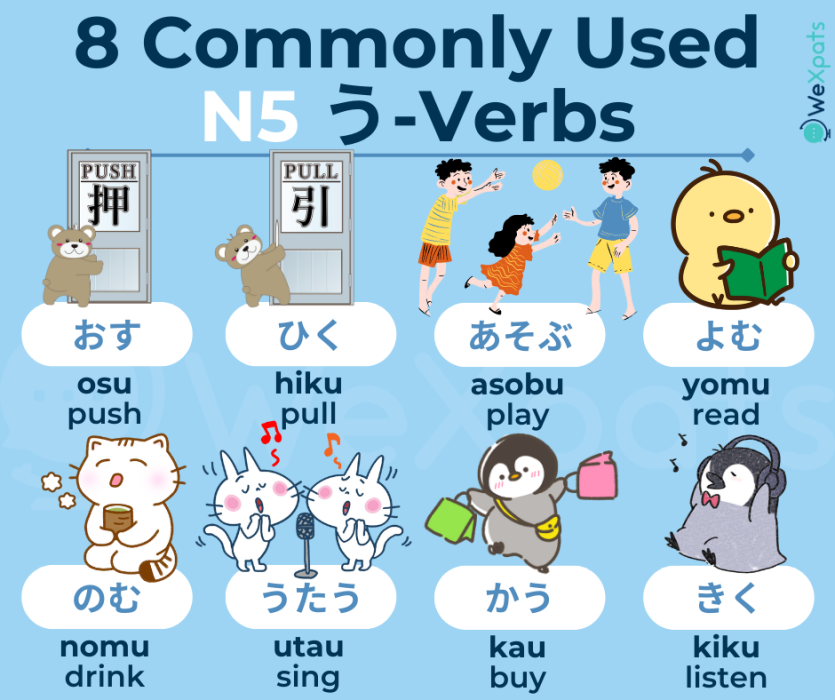
う動詞 (u-doushi) or U-verbs are verbs that end with う (u).
It is the most complex verb group to conjugate as U-verbs have many rules to follow. Another difficult part about U-verbs is the confusion with Ru-verbs.
Generally, verbs that end with る (ru) are Ru-verbs, but there are exceptions where they are classified as a U-verb. This is because they are conjugated according to the rules of U-verb. There is no good way or trick to determine which type of verb it is, so just do your best to memorise them.
For example, 着る (kiru) - to wear is a Ru-verb, but 切る (kiru) - to cut is a U-verb.
When conjugated into polite form, 着る (kiru) becomes 着ます (kimasu) following the Ru-verb conjugation rule. Whereas, 切る (kiru) becomes 切ります (kirimasu) following the U-verb rules.
Conjugating U-verbs to present negative (ない nai) form and past negative (なかった nakatta) form is easy enough as they share the same rules.
The chart below shows how to conjugate U-verbs into present negative and past negative form.
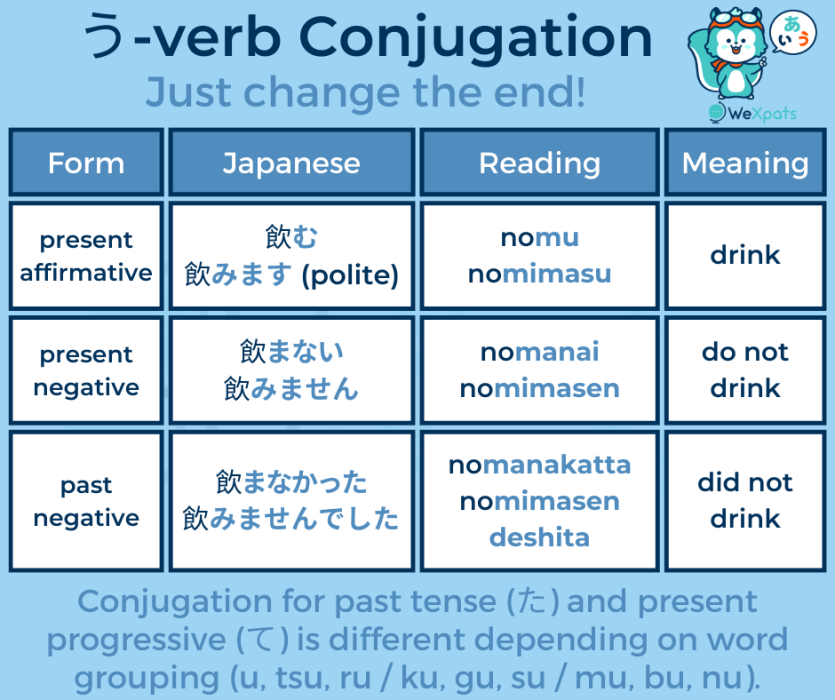
However, for past tense (た ta) form and present progressive (て te) form requires further dividing U-verbs into 3 groups based on their ending:
- Group 1 : う (u), つ (tsu), る (ru)
- Group 2 : く(ku), ぐ (gu), す (su)
- Group 3 : む (mu), ぶ (bu), ぬ (nu)
And here’s how to conjugate U-verbs into past tense.
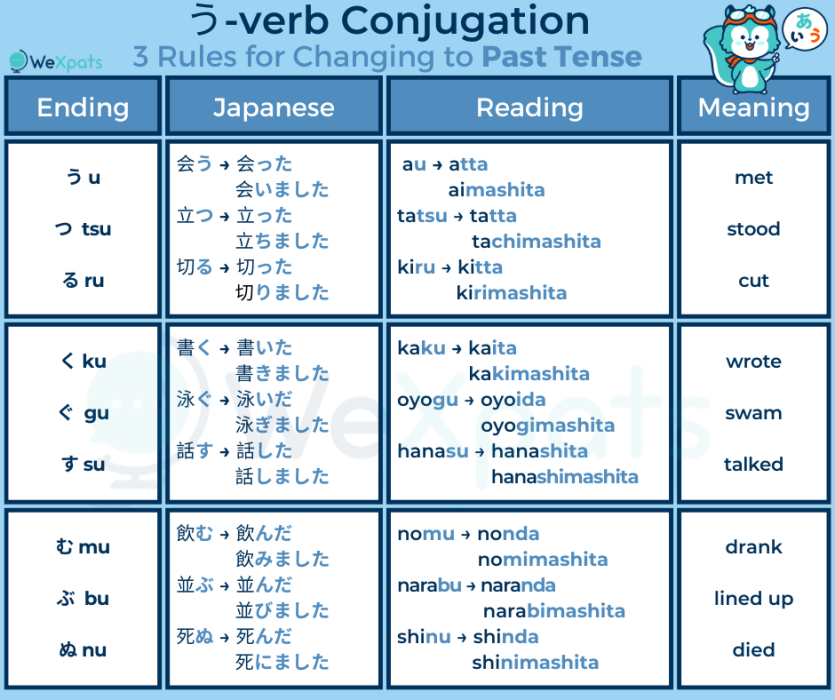
Once you have learned how to conjugate U-verbs into past tense, then present progressive is incredibly easier. Just change the た (ta) て (te) , or だ (da) to で (de).
Have a look below on how to conjugate U-verbs into present progressive form.
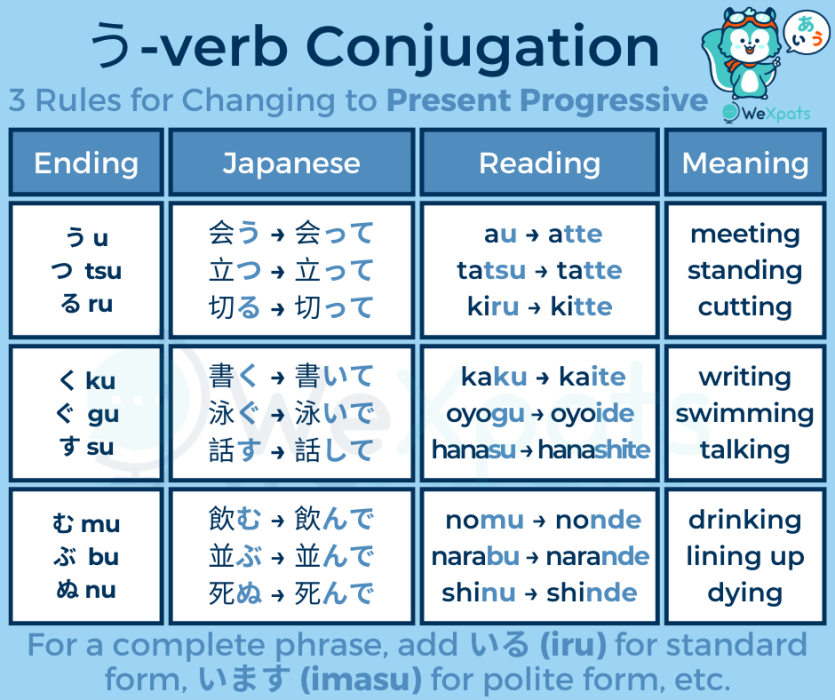
Ending a Japanese phrase or sentence in present progressive is incorrect. Though, for example, 飲んで (nonde) itself is a verb, it is only a complete phrase when combined with another verb.
For example, with いる (iru) to form 飲んでいる (nondeiru), or combined with います (imasu) forming 飲んでいます (nondeimasu) for a polite phrase that means “I am drinking”.
Another example, with ください (kudasai) to form 飲んでください (nondekusai) meaning “Please drink”.
U-verbs List
Here’s a list of 76 N5 U-verbs that you need to know for the test. We also recommending practising conjugating them.
Note: The Kanji characters you need to know at the N5 level are indicated in BOLD.
|
あく |
開く |
opened / is open (door, etc.) |
|
あらう |
洗う |
to wash |
|
ある |
to be; to have; to be located |
|
|
あそぶ |
遊ぶ |
to play |
|
あう |
会う |
to meet; to encounter |
|
ちがう |
違う |
to differ; to be wrong |
|
だす |
出す |
to take out; to get out; to put out; to reveal; to submit |
|
ふく |
吹く |
to blow (wind) |
|
ふる |
降る |
falls (rain, snow, etc.) |
|
はいる |
入る |
to enter; to go in; to include |
|
はじまる |
始まる |
began / begin ; started / starts ; commenced / commences |
|
はく |
履く |
to put on (pants, shoes, skirt, etc. lower-body clothing) |
|
はなす |
話す |
to talk; to speak; to chat |
|
はる |
貼る |
to stick; to paste |
|
はしる |
走る |
to run |
|
はたらく |
働く |
to work |
|
ひく |
引く |
to pull |
|
ひく |
弾く |
to play (guitar, piano etc. stringed or keyboard instrument) |
|
いく |
行く |
to go; to move (towards); to head (towards) |
|
いる |
要る |
to need; to want |
|
いう |
言う |
to say; to call |
|
かえる |
帰る |
to go back; to go home; to return somewhere |
|
かえす |
返す |
to return something |
|
かかる |
掛かる |
to take up (a resource, e.g. time or money) |
|
かく |
書く |
to write |
|
かす |
貸す |
to lend; to loan |
|
かう |
買う |
to buy |
|
けす |
消す |
to erase; to delete; to turn off (light, switch, etc.); to extinguish (fire, candle, etc.) |
|
きく |
聞く |
to hear; to listen; to ask; to learn of |
|
きる |
切る |
to cut |
|
こまる |
困る |
to be troubled; to have difficulty; to be inconvenienced |
|
くもる |
曇る |
to get cloudy; to fog up; to become dim |
|
まがる |
曲がる |
to bend; to curve; to turn |
|
まつ |
待つ |
to wait |
|
みがく |
磨く |
to polish; to shine; to brush (teeth) |
|
もつ |
持つ |
to hold; to carry; to possess; to own |
|
もっていく |
持って行く |
to bring (something) along; to carry (something) away |
|
なく |
鳴く |
to make sound (by an animal); to chirp (bird) |
|
なくす |
無くす |
to lose (something) |
|
ならぶ |
並ぶ |
to line up; to stand in a line |
|
ならう |
習う |
to learn (from a teacher); to be taught |
|
なる |
成る |
to become; to change (into) |
|
のぼる |
登る |
to climb |
|
のむ |
飲む |
to drink |
|
のる |
乗る |
to get on (train, plane, bus, ship, etc.) |
|
ぬぐ |
脱ぐ |
to undress; to strip |
|
おく |
置く |
to put; to place |
|
おす |
押す |
to push; to press |
|
おわる |
終わる |
to finish; to end |
|
およぐ |
泳ぐ |
to swim |
|
さく |
咲く |
to bloom |
|
さす |
差す |
to extend hands; to raise (an umbrella, etc.) |
|
しまる |
閉まる |
to be shut; to close; to be closed |
|
しぬ |
死ぬ |
to die |
|
しる |
知る |
to know; to find out |
|
すむ |
住む |
to live (somewhere); to reside; to stay |
|
すう |
吸う |
to smoke; to suck; to inhale; to absorb |
|
すわる |
座る |
to sit |
|
たのむ |
頼む |
to request |
|
たつ |
立つ |
to stand |
|
とぶ |
飛ぶ |
to fly; to jump |
|
とまる |
止まる |
to stop (moving); to come to a stop |
|
とる |
撮る |
to take (a photograph); to record (audio, video) |
|
とる |
取る |
to take; to pick up; to grab; to catch; to pass; to get; to obtain |
|
つかう |
使う |
to use |
|
つく |
着く |
to arrive at; to reach |
|
つくる |
作る |
to make |
|
うる |
売る |
to sell |
|
うたう |
歌う |
to sing |
|
わかる |
分かる |
to understand |
|
わたる |
渡る |
to cross over (bridge, etc.) |
|
わたす |
渡す |
to hand over; to pass |
|
やる |
to do |
|
|
やすむ |
休む |
to rest; to have a break; to be absent; to take a day off |
|
よぶ |
呼ぶ |
to call; to call out (to); to invite |
|
よむ |
読む |
to read; to recite |
More on Suru-verbs and Irregular Verbs
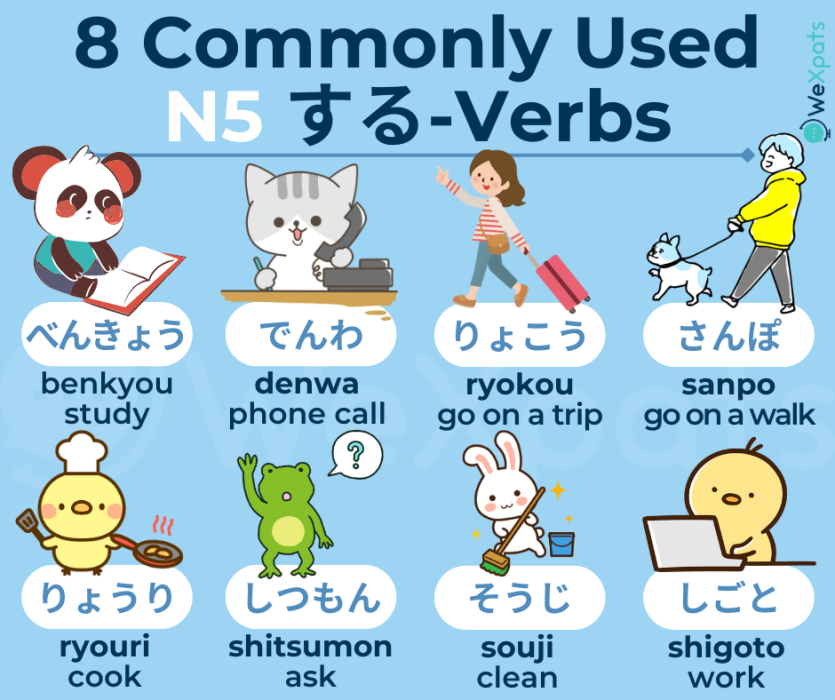
する動詞 (suru-doushi) or Suru-verbs are nouns that when adding する (suru) to the end becomes a verb.
する (suru) itself is a verb that means “to do”. する (suru) is an irregular verb that follows its own set of rules. By adding it to certain nouns, it changes to become a verb.
For example, 電話 (denwa) is “telephone”, but 電話する (denwasuru) means “(make a) telephone call)”.
Conjugating Suru-verbs is incredibly easy, just follow the chart below.
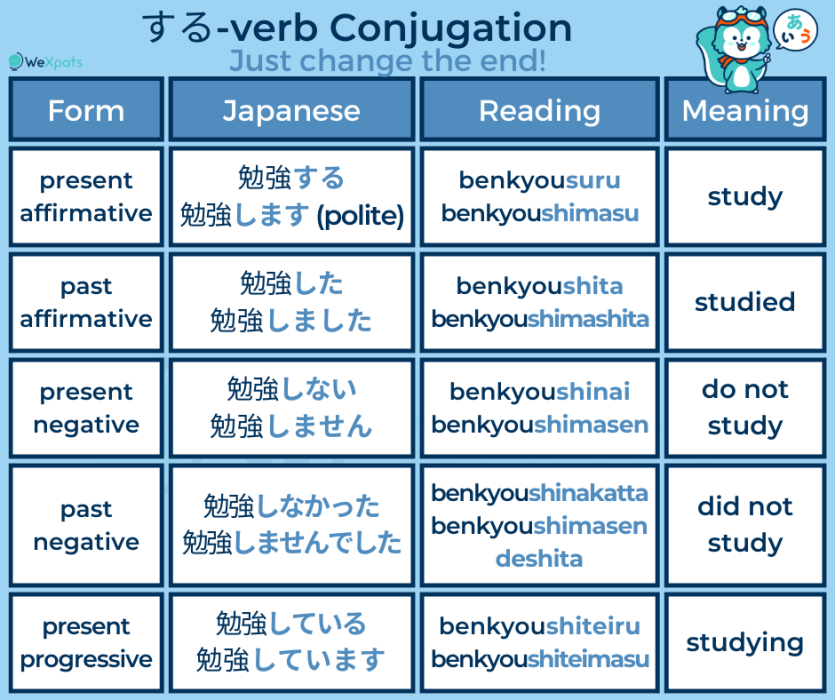
Another irregular verb is 来る (kuru) - come, that follows its own rules.
The chart below shows the conjugation rules for irregular verbs 来る
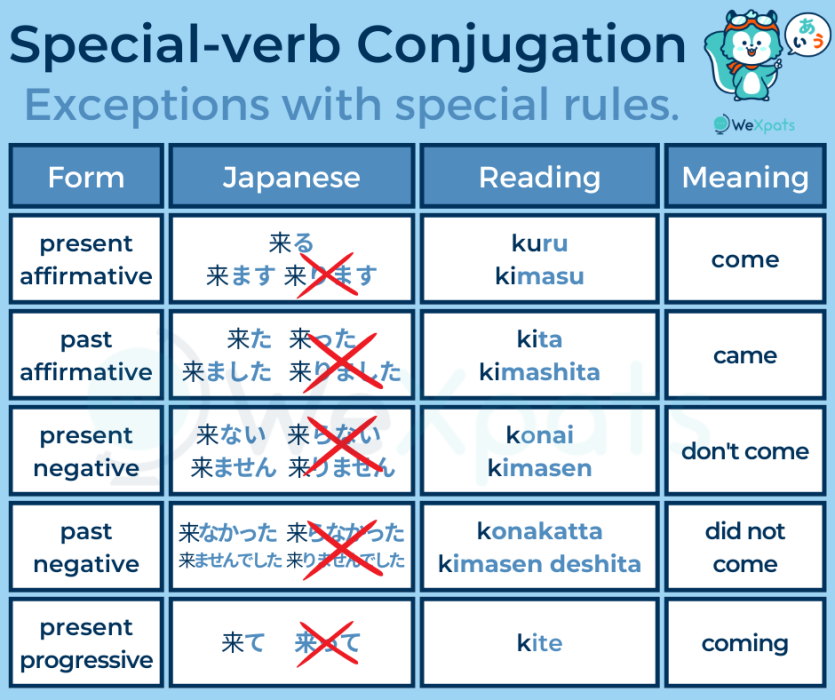
行く (iku) - go, is a U-verb that follows the U-verbs conjugation rules, except when conjugating into past affirmative and present progressive form.
Check the chart below.
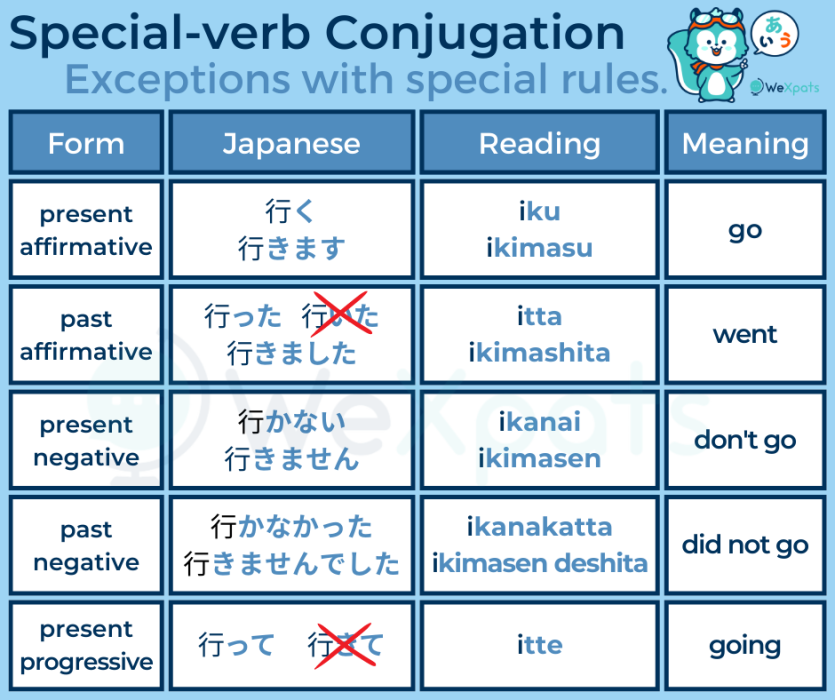
Suru-verbs List
Here’s a list of 16 Suru-verbs that you need to learn for the test and are commonly used in daily life. There are not many at the N5 level.
Note: The Kanji characters you need to know at the N5 level are indicated in BOLD.
|
べんきょう |
勉強 |
to study |
|
でんわ |
電話 |
to make a phone call |
|
じゅぎょう |
授業 |
to give a class; to teach a lesson |
|
かいもの |
買い物 |
to do shopping |
|
けっこん |
結婚 |
to marry; to get married |
|
コピー |
to make a photocopy; to make a copy |
|
|
れんしゅう |
練習 |
to practice |
|
りょこう |
旅行 |
to go on a trip |
|
りょうり |
料理 |
to cook |
|
さんぽ |
散歩 |
to go on a walk; to take a stroll |
|
せんたく |
洗濯 |
to do laundry |
|
しごと |
仕事 |
to work |
|
しつもん |
質問 |
to ask a question; to make an inquiry |
|
そうじ |
掃除 |
to clean; to sweep; to tidy up |
|
テスト |
to take a test, examination, etc. |
And the irregular verb 来る (kuru).
|
くる |
来る |
to come |



































